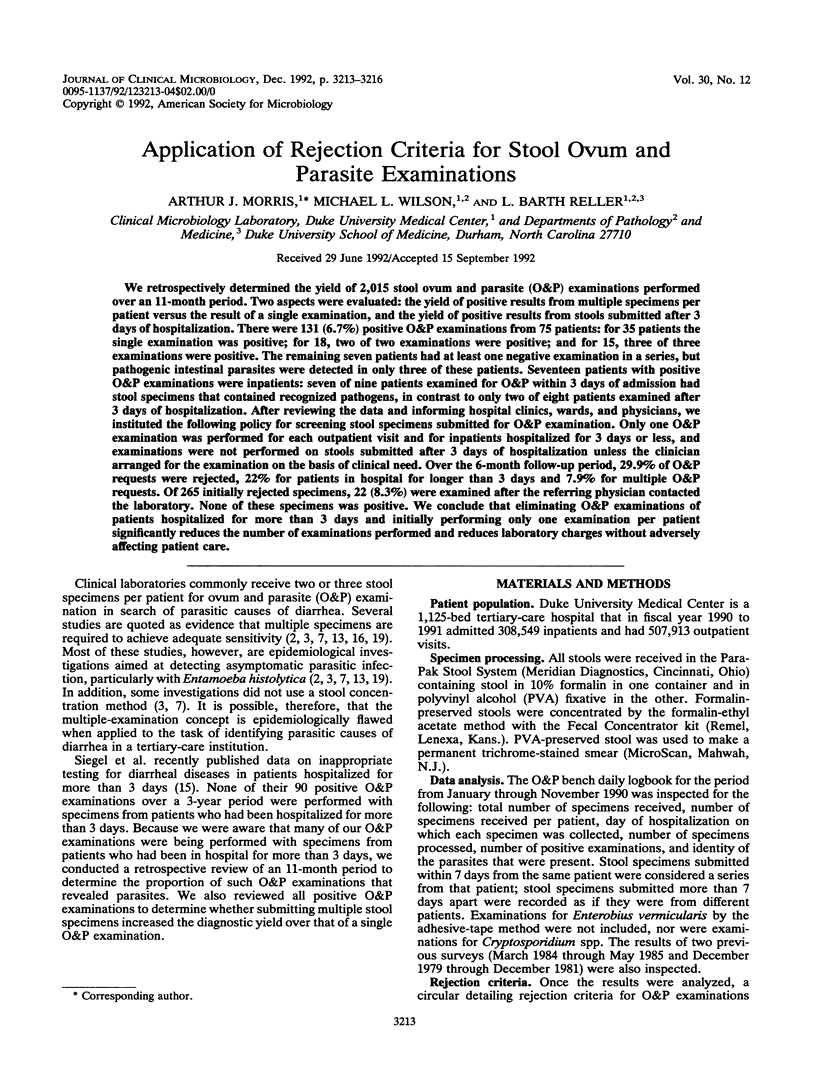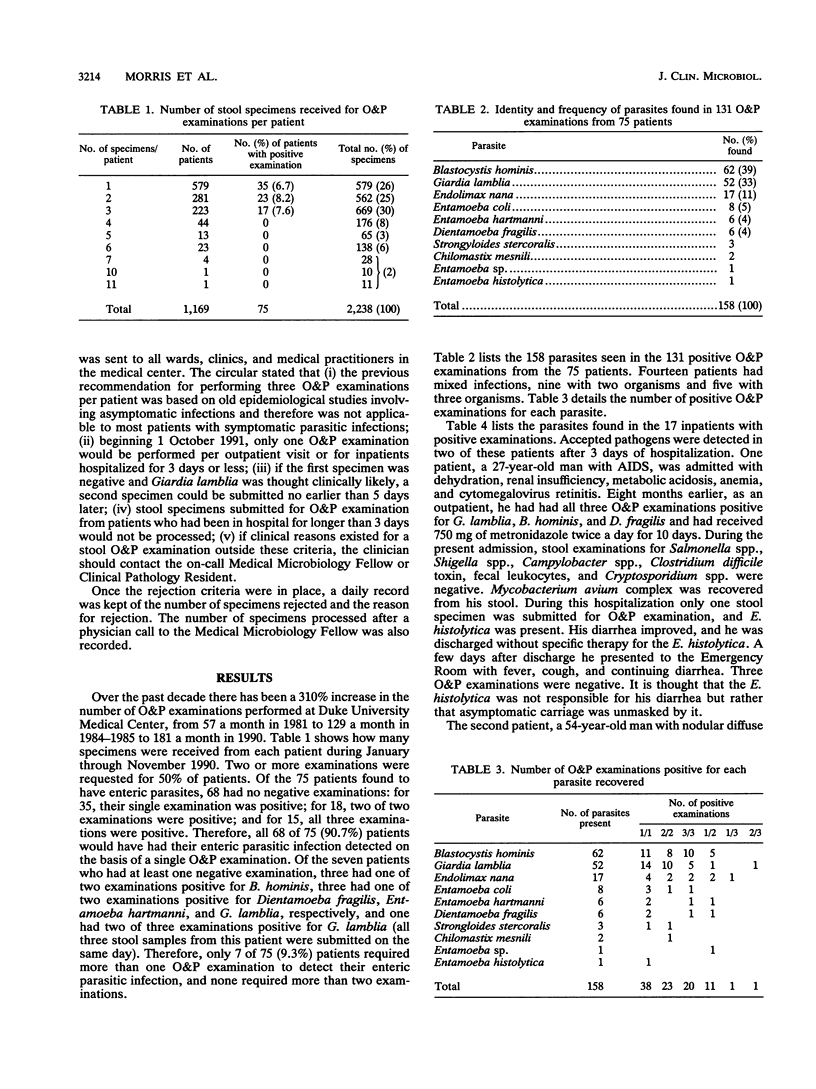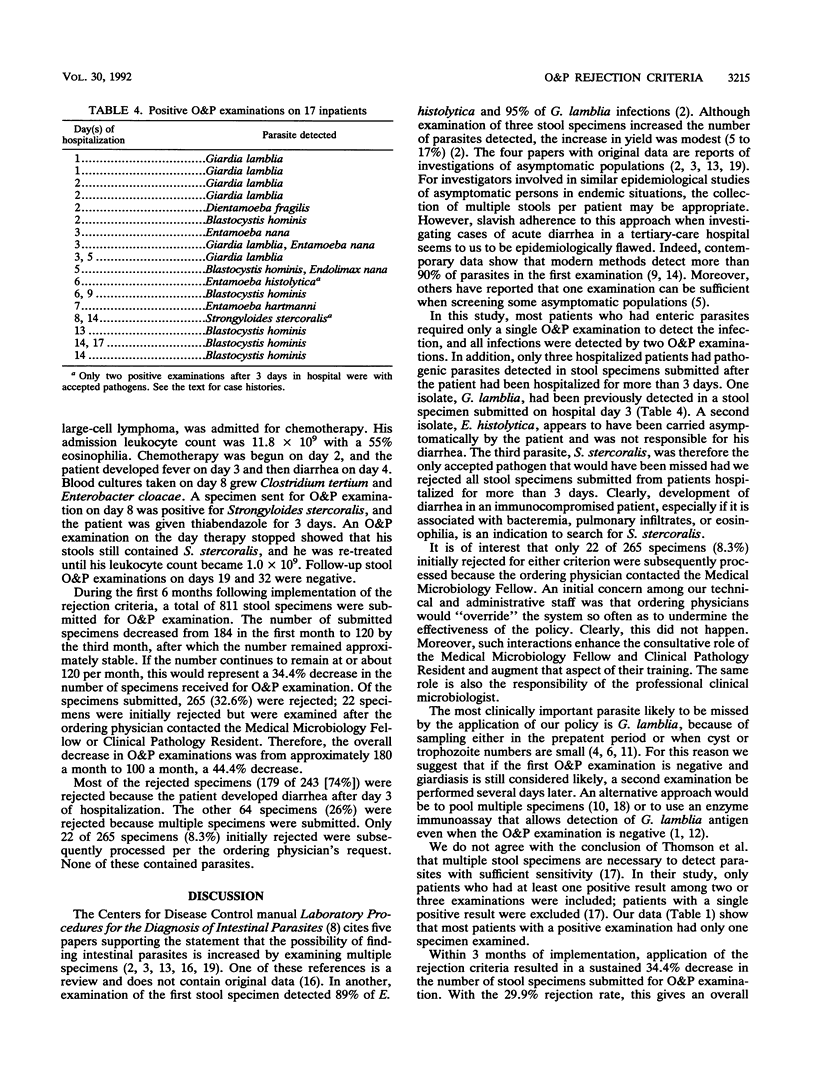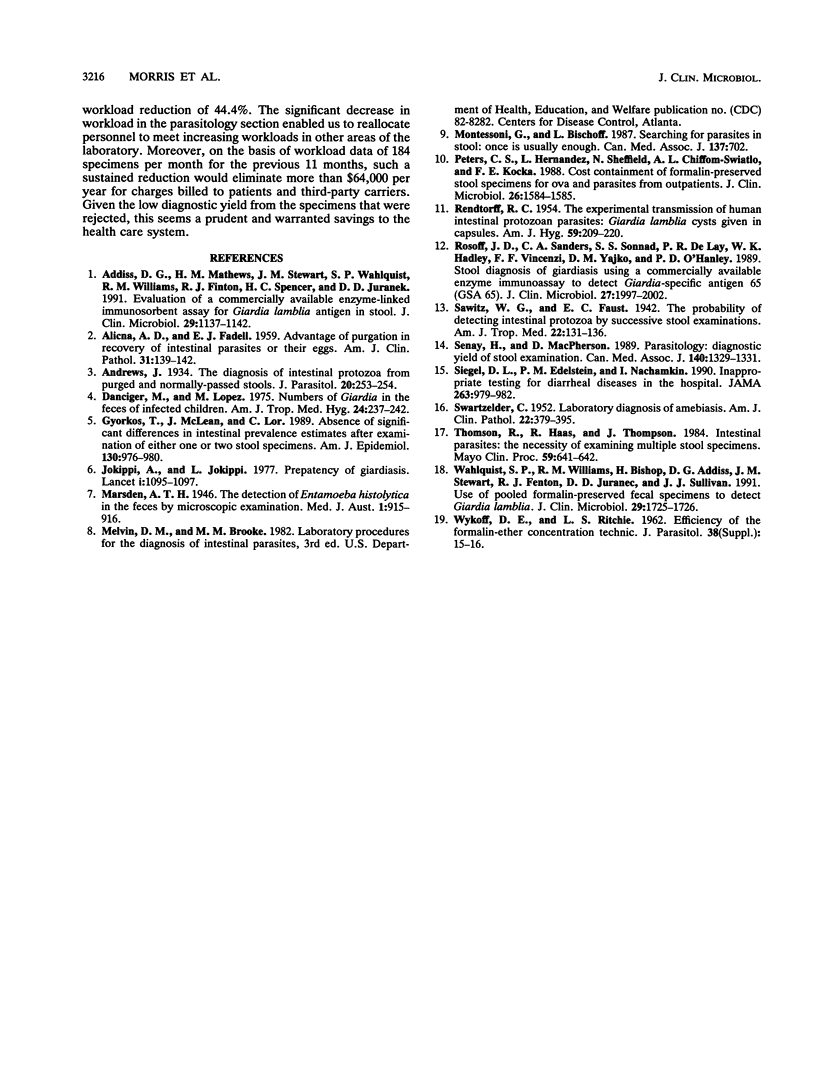Abstract
We retrospectively determined the yield of 2,015 stool ovum and parasite (O&P) examinations performed over an 11-month period. Two aspects were evaluated: the yield of positive results from multiple specimens per patient versus the result of a single examination, and the yield of positive results from stools submitted after 3 days of hospitalization. There were 131 (6.7%) positive O&P examinations from 75 patients: for 35 patients the single examination was positive; for 18, two of two examinations were positive; and for 15, three of three examinations were positive. The remaining seven patients had at least one negative examination in a series, but pathogenic intestinal parasites were detected in only three of these patients. Seventeen patients with positive O&P examinations were inpatients: seven of nine patients examined for O&P within 3 days of admission had stool specimens that contained recognized pathogens, in contrast to only two of eight patients examined after 3 days of hospitalization. After reviewing the data and informing hospital clinics, wards, and physicians, we instituted the following policy for screening stool specimens submitted for O&P examination. Only one O&P examination was performed for each outpatient visit and for inpatients hospitalized for 3 days or less, and examinations were not performed on stools submitted after 3 days of hospitalization unless the clinician arranged for the examination on the basis of clinical need. Over the 6-month follow-up period, 29.9% of O&P requests were rejected, 22% for patients in hospital for longer than 3 days and 7.9% for multiple O&P requests. Of 265 initially rejected specimens, 22 (8.3%) were examined after the referring physician contacted the laboratory. None of these specimens was positive. We conclude that eliminating O&P examinations of patients hospitalized for more than 3 days and initially performing only one examination per patient significantly reduces the number of examinations performed and reduces laboratory charges without adversely affecting patient care.
Full text
PDF



Selected References
These references are in PubMed. This may not be the complete list of references from this article.
- ALICNA A. D., FADELL E. J. Advantage of purgation in recovery of intestinal parasites or their eggs. Am J Clin Pathol. 1959 Feb;31(2):139–141. doi: 10.1093/ajcp/31.2.139. [DOI] [PubMed] [Google Scholar]
- Addiss D. G., Mathews H. M., Stewart J. M., Wahlquist S. P., Williams R. M., Finton R. J., Spencer H. C., Juranek D. D. Evaluation of a commercially available enzyme-linked immunosorbent assay for Giardia lamblia antigen in stool. J Clin Microbiol. 1991 Jun;29(6):1137–1142. doi: 10.1128/jcm.29.6.1137-1142.1991. [DOI] [PMC free article] [PubMed] [Google Scholar]
- Danciger M., Lopez M. Numbers of Giardia in the feces of infected children. Am J Trop Med Hyg. 1975 Mar;24(2):237–242. doi: 10.4269/ajtmh.1975.24.237. [DOI] [PubMed] [Google Scholar]
- Gyorkos T. W., MacLean J. D., Law C. G. Absence of significant differences in intestinal parasite prevalence estimates after examination of either one or two stool specimens. Am J Epidemiol. 1989 Nov;130(5):976–980. doi: 10.1093/oxfordjournals.aje.a115430. [DOI] [PubMed] [Google Scholar]
- Jokipii A. M., Jokipii L. Prepatency of giardiasis. Lancet. 1977 May 21;1(8021):1095–1097. doi: 10.1016/s0140-6736(77)92345-5. [DOI] [PubMed] [Google Scholar]
- Peters C. S., Hernandez L., Sheffield N., Chittom-Swiatlo A. L., Kocka F. E. Cost containment of formalin-preserved stool specimens for ova and parasites from outpatients. J Clin Microbiol. 1988 Aug;26(8):1584–1585. doi: 10.1128/jcm.26.8.1584-1585.1988. [DOI] [PMC free article] [PubMed] [Google Scholar]
- RENDTORFF R. C. The experimental transmission of human intestinal protozoan parasites. II. Giardia lamblia cysts given in capsules. Am J Hyg. 1954 Mar;59(2):209–220. doi: 10.1093/oxfordjournals.aje.a119634. [DOI] [PubMed] [Google Scholar]
- Rosoff J. D., Sanders C. A., Sonnad S. S., De Lay P. R., Hadley W. K., Vincenzi F. F., Yajko D. M., O'Hanley P. D. Stool diagnosis of giardiasis using a commercially available enzyme immunoassay to detect Giardia-specific antigen 65 (GSA 65). J Clin Microbiol. 1989 Sep;27(9):1997–2002. doi: 10.1128/jcm.27.9.1997-2002.1989. [DOI] [PMC free article] [PubMed] [Google Scholar]
- SWARTZWELDER C. Laboratory diagnosis of amebiasis. Am J Clin Pathol. 1952 Apr;22(4):379–395. [PubMed] [Google Scholar]
- Senay H., MacPherson D. Parasitology: diagnostic yield of stool examination. CMAJ. 1989 Jun 1;140(11):1329–1331. [PMC free article] [PubMed] [Google Scholar]
- Siegel D. L., Edelstein P. H., Nachamkin I. Inappropriate testing for diarrheal diseases in the hospital. JAMA. 1990 Feb 16;263(7):979–982. [PubMed] [Google Scholar]
- Thomson R. B., Jr, Haas R. A., Thompson J. H., Jr Intestinal parasites: the necessity of examining multiple stool specimens. Mayo Clin Proc. 1984 Sep;59(9):641–642. doi: 10.1016/s0025-6196(12)62418-5. [DOI] [PubMed] [Google Scholar]
- Wahlquist S. P., Williams R. M., Bishop H., Addiss D. G., Stewart J. M., Finton R. J., Juranek D. D., Sullivan J. J. Use of pooled formalin-preserved fecal specimens to detect Giardia lamblia. J Clin Microbiol. 1991 Aug;29(8):1725–1726. doi: 10.1128/jcm.29.8.1725-1726.1991. [DOI] [PMC free article] [PubMed] [Google Scholar]


